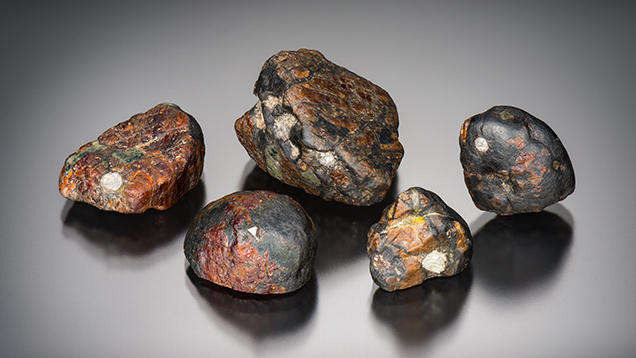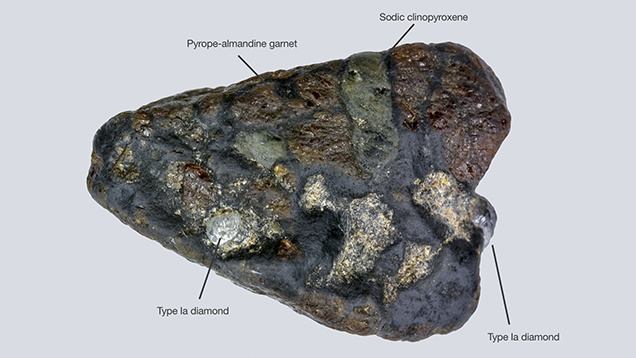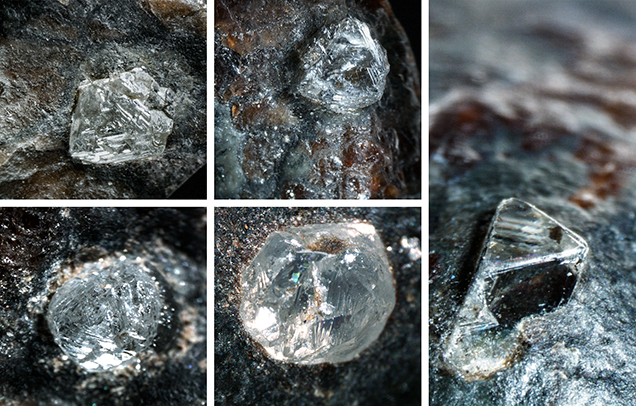Diamond-Bearing Eclogite Xenoliths from the Ardo So Ver Dykes

Recently, five small rock samples containing diamond crystals (figure 1) were sent to GIA Research for examination. The samples were submitted by Charles Carmona (Guild Laboratories, Los Angeles) on behalf of owners Jahn Hohne (Ekapa Mining, Kimberley, South Africa) and Vince Gerardis (an occasional trader and collector of unique diamonds and producer of the television series “Game of Thrones”). The specimens were sourced over 25 years ago from a kimberlite fissure mine located 40 miles (65 km) northwest of Kimberley, South Africa. The So Ver mine is located in a group of narrow kimberlite dykes discovered in the 1940s, known as the Ardo dykes, that intruded into Ventersdorp lavas and overlying Karoo shales (M. Field et al., “Kimberlite-hosted diamond deposits of southern Africa: A review,” Ore Geology Reviews, Vol. 34, 2008, pp. 33–75).
Mineralogical examination using microscopy and Raman spectroscopy revealed that the rocks were composed primarily of garnet and clinopyroxene and would be classified as eclogite xenoliths (figure 2). In simple terms, eclogites are metamorphic rocks, typically created when basaltic crust from the ocean floor is subducted deep into the earth’s mantle where high temperatures and pressures cause chemical reactions that change the basaltic minerals into garnet and clinopyroxene. Eclogites, along with peridotites, are considered the most common mantle host rocks for diamond crystallization. EDXRF chemical analysis of the garnets and clinopyroxenes in these samples showed pyrope mole fractions up to about 49% and jadeite mole fractions up to approximately 31%. These results are consistent with other reported diamond-bearing eclogites (T.F. Fung and S.E. Haggerty, “Petrography and mineral compositions of eclogites from the Koidu Kimberlite Complex, Sierra Leone,” Journal of Geophysical Research, Vol. 100, 1995, pp. 20451–20473).

Figure 2. These five diamond-bearing eclogite xenoliths from the Ardo So Ver dykes in South Africa ranged in weight from 2.24 to 12.40 grams, with the largest measuring 2.5 centimeters in length. Photo by Kevin Schumacher.
The diamond crystals in the xenoliths ranged from 1.5 to 4.0 mm in length, and were transparent and near-colorless to pale yellow (figure 3). They occurred as octahedral and combination forms with no visible resorption. No inclusions were visible within the crystals under 10× magnification. FTIR analysis (using an FTIR microscope in reflected light mode) revealed that all of the diamonds were type Ia with abundant nitrogen impurities. Three of the seven diamonds analyzed showed nitrogen impurities dominantly as A-aggregates in concentrations ranging from approximately 420 to 800 ppm.
Figure 3. Seven transparent, near-colorless to pale yellow gem diamonds (five shown in these photos) were observed in the eclogite samples, ranging in length from 1.5 to 4.0 mm. Photos by Christopher M. Breeding.
The data provided here, along with additional ongoing work, will hopefully shed more light on the temperature, pressure, and depth in the earth’s mantle where the diamonds crystallized.



